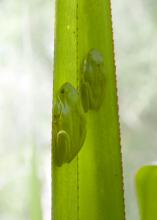Information Possibly Outdated
The information presented on this page was originally released on July 17, 2015. It may not be outdated, but please search our site for more current information. If you plan to quote or reference this information in a publication, please check with the Extension specialist or author before proceeding.
Frog calls tell us love is in the air
By Jeanne Jones, Professor, and Daryl Jones, Extension Professor
MSU Forest and Wildlife Research Center
Mississippi State University
STARKVILLE, Miss. -- Our childhood was full of memorable experiences related to wildlife, thanks to our father’s encouragement on family outings, including one that conjured unusual images of frogs.
Hardwood forests interspersed with swamps and small wetlands flanked the sides of the country road on which we rode. Daddy slowed the car and lowered the window as a misty spring rain fell. Fog slowly drifted upward in vertical clouds from the warm forest floor and wetlands.
He pointed and said, “Look …that’s where the frogs are cooking supper.”
We looked and listened with a sense of mystery and magic as choruses of small creatures reached our ears.
This sense of wonder and appreciation for frogs, toads and wild places has never left us. Both of us are biologists now, and we still look forward to the calls that resound during our hot Southern nights: songs sung by amorous amphibians calling for potential mates.
Of course, we know now that frogs and toads don’t cook their supper. They dine on insects and other small creatures, including mosquitoes and biting flies. However, we also know these animals are important in the food web because of their importance as prey to many types of wildlife and even insects.
At least 28 different types of frogs and toads inhabit Mississippi’s landscape. Most are active during warm spring and summer months, but some species, such as leopard frogs, chorus frogs, cricket frogs, crawfish frogs and spring peepers, may be heard calling during winter and early spring when temperatures hover near freezing. Each species has a different call, and biologists can study frog and toad communities by identification of their species-specific vocalizations.
During breeding periods, Mississippi’s frogs and toads seek out surface water in which to lay their eggs. The sounds we hear echoing from wetlands, pools, lakes, ponds and even water in ditches are songs sung by males trying to attract prospective mates. A female lays eggs into the water as a male hangs onto her back in a behavior called “amplexus.” Eggs are fertilized in the water, and the small embryos encased in gelatinous layers develop rapidly into tadpoles.
After hatching, tadpoles will spend their larval lives in the water feeding on algae and other plant materials. Tadpoles of some species, such as bullfrogs, feed on insect eggs, invertebrates and other frog larvae. Tadpoles must mature quickly due to the potential for their nursery pools to “dry up.”
As it emerges from the pool where it was born, the young frog looks like a tiny adult model with a remnant of its tadpole tail -- a metamorph! The tadpole quickly absorbs its tail and begins its adult life on land.
As adults, most frogs and toads feed on insects and other small invertebrates. They often seek moist areas and live beneath logs, rocks and leaf litter during daylight hours. The toads you see in your yard on warm, moist evenings have been spending the day in small burrows underground until they emerge at night to search for food.
In northern and central Mississippi, common frog species are cricket frogs, chorus frogs, spring peepers, leopard frogs, bullfrogs, bronze frogs, green tree frogs, squirrel tree frogs, Cope’s gray tree frogs and bird-voiced tree frogs. Toad species include the spadefoot, narrowmouth and Fowler’s toads.
These animals are important parts of Mississippi’s ecosystems because they eat many insects and other invertebrates, many of which cause damage and health issues for humans. In turn, frogs and toads provide prey for many animals.
Most frogs are good indicators of clean water and healthy ecosystem function. They are sensitive to pollution due to their moist skin layers, which absorb oxygen and other chemicals in the environment. They are also part of Mississippi’s cultural and natural heritage. Many a child has scooped up tadpoles from a water puddle or marveled at how far an adult frog can jump.
Many Southerners value bullfrogs as a game species and dietary delicacy. But some of us still live under the illusion that one evening we will sneak into a chorus of calling frogs deep in a Southern swamp and find at least one of them cooking in a small Dutch oven dangling from a low-hanging cypress branch!

Editor’s Note: Extension Outdoors is a column authored by several different experts in the Mississippi State University Extension Service.




